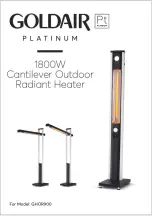
2. Connect the refrigerant connections to the domestic hot water tank
and the outdoor unit by applying refrigerant oil to the beaded parts to
facilitate tightening and improve the seal, while keeping to the
following tightening torques:
External diameter of
the pipe (mm/inch)
External diameter of
the cone fitting (mm)
Torque load (N.m)
6.35 - 1/4
17
14 - 18
9.52 - 3/8
22
34 - 42
3. Carry out a seal test of the refrigerant circuit, putting it under a
pressure of up to 25 bar, in 5 bar increments.
4. Place the refrigerant installation under vacuum using a vacuum gauge
and a vacuum pump.
5. Check the pressure according to the recommendations table below:
Outside temperature in °C ≥ 20
10
0
- 10
Pressure to reach in Pa
(bar)
1000
(0.01)
600
(0.006)
250
(0.0025)
200
(0.002)
Evacuation time after
reaching the pressure in
hour(s)
1
1
2
3
6. Open the valves with a hexagonal key by turning anti-clockwise until it
stops.
7. Fit the insulation on the refrigerant connections on the domestic hot
water tank side.
The refrigerant connection insulation pieces are provided in the
documentation bag.
7.5
Electrical connections
7.5.1
Electrical recommendations
Only qualified professionals may carry out electrical connections, always
with the power off.
Separate the very low voltage cables from the 230V circuit cables.
The electrical power supply is done by means of a mains connection cable
(~230 V, 50 Hz) in accordance with prevailing national regulations for
electrical installations.
Respect the polarities when making the electrical connections to the
mains:
Brown wire (L) : Live
Blue wire (N) : Neutral
Green/yellow wire
: Earth
1. If the power supply cable is damaged, you must have it replaced by a
qualified installer.
2. Do not connect the power supply directly to the peak/off-peak rate
contact.
7 Installation
38
7689749 - v03 - 25112019
Содержание BC ACS 150 SPLIT
Страница 62: ...14 Appendix 62 7689749 v03 25112019 ...
Страница 64: ...7689749 v03 25112019 7689749 001 03 ...
















































